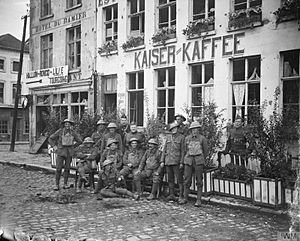Battle of the Lys and the Escaut facts for kids
Quick facts for kids Battle of the Lys and the Escaut, 1918 |
|||||||
|---|---|---|---|---|---|---|---|
| Part of the Hundred Days Offensive of the First World War | |||||||
 British and Belgian soldiers outside a German cafeteria called "Kaiser Kaffee" in Menin, October 1918. |
|||||||
|
|||||||
| Belligerents | |||||||
| Commanders and leaders | |||||||
The Battle of the Lys and the Escaut was a very important battle during the end of First World War. It happened in Belgium from October 20 to November 11, 1918. This battle was the final part of a bigger fight called the Second Battle of Belgium. It was also known as the Ypres-Lys Offensive.
Contents
Why This Battle Happened
In August 1918, the Allied forces began a huge attack across the Western Front. This attack was called the Hundred Days Offensive. In Belgium, a special group of armies was formed. It was named the Groupe d'Armées des Flandres (GAF).
Who Led the Allied Forces?
The GAF was led by King Albert I of Belgium. French General Jean Degoutte was his Chief of Staff. This group included:
- Twelve Belgian army divisions.
- Ten divisions from the British Second Army.
- Six divisions from the French Sixth Army.
Earlier Battles in the Offensive
The first part of this big attack happened in September 1918. The German 4th Army was defeated in the Fifth Battle of Ypres. The town of Passchendaele was taken back by the Allies.
Bad weather and problems with supplies slowed down the advance in early October. But by the middle of the month, the GAF started the second phase. This was the Battle of Courtrai. During this battle:
- The French army captured Roulers.
- The Belgian army took Ostend, Bruges, and Zeebrugge.
- The British army captured Courtrai, Lille, and Douai.
These battles tired out the Allied soldiers. So, two American army divisions, the 37th and 91st, were sent to Belgium. They were there to help with the third part of the attack. The main goal was to push the German forces east of the Escaut (Scheldt) River.
Allied Army Setup
Here's how the Allied forces were organized from north to south:
- The Belgian Army was led by King Albert I of Belgium. It had 12 divisions.
- The French 6th Army was led by Antoine Baucheron de Boissoudy. It included:
- The 34th Army Corps with the 77th, 70th, and 11th French Divisions.
- The 30th Army Corps with the 12th French Division and the 37th US Division.
- The 7th Army Corps with the 128th French Division, the 91st US Division, and the 41st French Division.
- The British 2nd Army was led by General Herbert Plumer. It had 10 divisions.
The Battle Unfolds
The fighting took place in different areas.
Northern Front
In the north, the German army had strong defenses behind the Deinze-Bruges Canal. They fought hard against Belgian attacks from October 20 to 31. By November 2, the Germans had to retreat to the Ghent–Terneuzen Canal. They held this position until the war ended. By November 10, the Belgian Army had reached the edge of Ghent.
Southern Front
In the south, the British army moved forward steadily. The city of Valenciennes was captured on November 2. The British reached Mons on November 10. Here, two soldiers, George Edwin Ellison and George Lawrence Price, were killed. They were the last British and British Empire soldiers to die during the First World War.
Central Front
In the middle, the 91st US Division faced very strong German resistance near Waregem. They suffered many losses in a place called Spitaals Bosschen. The French 6th Army and the 37th US Division advanced more easily between the Lys and Escaut rivers. However, they met fierce resistance when they reached the Escaut River on November 1.
Several attempts to cross the river on the night of November 1 and 2 failed. Only the 37th US Division managed to get across and create a small foothold at Oudenaarde. From November 3 to November 8, the Allied forces had to stop and reorganize. On November 8 and 9, the French launched a new attack. The Germans pushed them back, but the French still managed to create another foothold between Oudenaarde and Melden.
What Happened Next
A new plan was made to cross the Escaut River and reach Brussels. This attack was set for November 10. However, it was canceled because it became clear that a ceasefire, called an armistice, was about to happen.
The German army's retreat was not a complete defeat. They managed to retreat in an organized way. They used very mobile "Maschinen Gewehr Kompanien" (machine gun companies) to attack the advancing Allies. These attacks caused many casualties. For example, the Belgian Army lost one-fifth of its soldiers between October 4 and November 11, 1918. This was one-third of all the losses they had during the entire war.
The sudden end of the war surprised many soldiers on both sides. This later led to a false idea known as the Stab-in-the-back myth. This myth claimed that the German Army was not truly defeated on the battlefield. Instead, it was supposedly betrayed by politicians at home.

